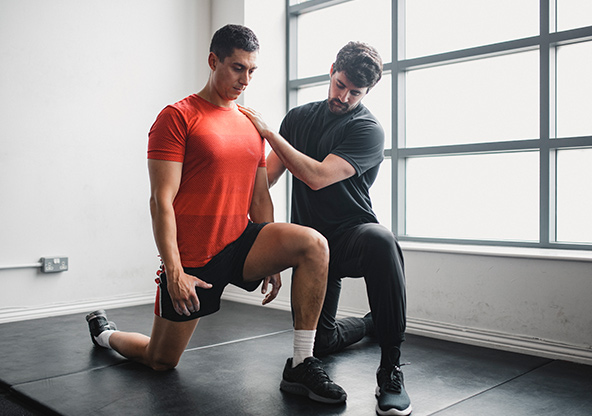A Strength Coach's POV: How to Recover From Injury
From Setback to Comeback: Inside a Strength Coach's Battle with Injury
Brian Thompson’s mom called him while he was at work and asked if he could stop by on his way home.
Like he did hundreds of times when leaving work, he took the back stairs at the Orthopedic and Sports Medicine Institute.
Brian was a strength coach for more than 20 years and is the director of sports medicine at the institute, so he is in top shape. He’s an avid hunter and runner and constantly tests the boundaries of his body's endurance and his mental toughness.
However, this time down the stairs, he missed a step. His knee overextended, and he hit the floor. Afterward, Brian could not put pressure on his leg.
Luckily, he fell inside the Orthopedic and Sports Medicine Institute, and nurses quickly rushed to his aid.
Diagnosed with a Quadriceps Tendon Rupture
Brian ruptured his quadriceps.
A quadriceps tendon rupture happens when the tendon connecting your kneecap to your thigh muscle tears, causing the kneecap to move out of place.
Even minor tears of the quad can cause pain and mobility issues, while severe ruptures need surgery and rehabilitation for full recovery.
These injuries are rare and are seen mostly during middle age,
said Dr. William Hobbs, CHRISTUS Health’s Institute Chair of Orthopedics, and an orthopedic surgeon at the Orthopedic and Sports Medicine Institute.
The CHRISTUS Orthopedic and Sports Medicine Institute provides comprehensive services and treatment for bone, joint, and muscle conditions, treating everyone from athletes to members throughout the community.
Immediate Feelings of Anger and Worry
Brian, 42, required six weeks of bed rest before he could start physical therapy on his leg.
Brian worried that he tore his ACL and MCL, tendons that stabilize the knee.
But after seeing Dr. Hobbs, Brian said his fear was eased.
Dr. Hobbs really helped me put things in perspective and helped me take one step at a time,
Brian said. It allowed me to have a positive attitude which I think helped with my quick recovery.
Once Brian understood his injury and knew he would be on bed rest for the next six weeks, he told himself he wanted to be the best patient he could be.
As a strength coach and someone who works at a facility that helps patients recover from injuries, he felt the need to set an example.
When feelings of anger at his injury came up, he tried his best to immediately adjust to positive thinking.
I did not want to allow myself to stay in my anger at what happened,
Brian said. I was going to be the best patient I could be, and I wanted to go in with a learner's mindset.
3 Principles to Recover from an Orthopedic Injury
Brian tried to live by three principles of recovery that he thinks can help other people with similar injuries.
- First, he said it was critical that he accepted he had the injury and he needed to forgive himself for rupturing his quad.
It was boring being on bed rest. Also, as business administrator and head of sports coaching at the Orthopedic and Sports Medicine Institute, he had many plans for the Institute.
- Second, he said he needed to stay positive no matter what. Although he had angry moments, he acknowledged them but did not dwell in resentment or self-pity.
It also helped tremendously that his wife was there to support him.
- The third principle is to have a learner's mind. The reason Brian needed to release his anger was to fully engage in the guidance of medical professionals for his recovery.
No matter how boring it is, you got to find a positive spin on it because the angrier you are, the more likely you will miss details about your recovery.
Throughout his recovery, Brian received straightforward guidance and objectives from the medical team, ensuring he understood every step. From initial consultations with Dr. Hobbs to detailed recovery plans laid out by his physical therapists, he was equipped with a clear roadmap to regain his strength and mobility.
With this mindset, it is a lot easier to take action on everything I learned,
Brian said.
Full Recovery in 2025
Brian is still working toward fully recovering from his quadriceps tendon rupture, eyeing a cautious return to high-intensity activities.
He has set his sights on resuming competitive events such as Spartan Races, hiking, and hunting, but not until 2025, to ensure his knee has fully healed.
Reflecting on his journey, Brian acknowledges the significant role his pre-injury fitness played in his recovery.
Being in peak physical condition was a crucial factor in how my injury didn't worsen,
Brian said. I believe my fitness level mitigated what could have been a much more serious injury.
While Brian credits his effective recovery to the solid physical foundation he built before the injury, the proper care and mindset also played a significant part in his recovery.
The process for me was straightforward—acknowledge the injury, undergo surgery, and focus on recovery,
Brian said. But I could not have gotten there without the guidance and support of my medical team.


